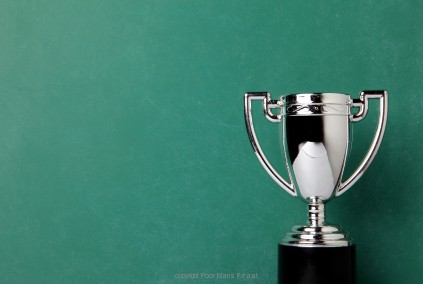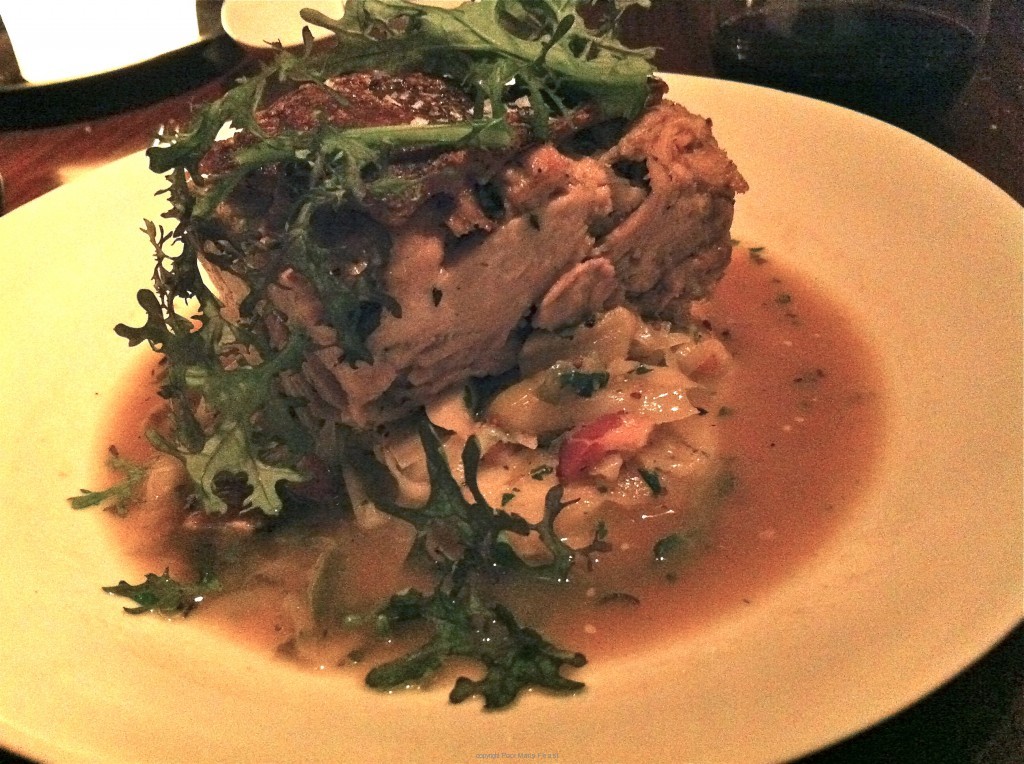We tried to outdo each other, over a bottle of wine.
Memorable dishes.
If your life revolves professionally and profoundly around food — around feeding and nurturing others; around properly honoring the most mundane ingredients in the privacy of your own little suburban ranch house kitchen while no one is there to watch whether or not you really walk the walk; around sifting culinary truth from trend, and political from phony — food ceases to be, as it should cease to be for everyone, just fuel. You remember the good, the great, and the bad. You remember the time the little gem lettuces were so fresh that a tiny, prenatally miniscule inchworm, having nestled itself snugly at the base between two leaves and fallen soundly asleep, was rudely awakened on your mother’s salad plate when she screamed at the top of her lungs and sent it back to the finest restaurant kitchen in California, citing cleanliness problems, before demanding the check. Or the time when, after three months of living on the bland chicken paillards your father steamed for you every day in a little broth while you suffered from teenage mono, your mother and her new boyfriend took you out for dinner at Oh-Ho-So, and they plunked a tiny dark brown clay pot in front of you, removed the cover, and the thick, pungently sweet essence of plum-braised squab wafted up and wrapped itself around you like a cashmere scarf, and you gasped.
The squash blossom frittata in the only restaurant in Orciatico, Susan says.
The pork roasted in hay at Chez Panisse, on my birthday in 2009, I say.
The chicken, dill, and noodle stew you made that time I had the flu in your apartment, she says.
The pork buns at Fatty Crab, I say.
The stuffed squash blossoms at Restaurant Six89 in Carbondale Colorado, she says.
The cacio e pepe at that tiny trattoria in Trastavere.
The cold fried chicken at the Small Holding Festival luncheon thrown by Canal House.
The watermelon pickle served with the cold fried chicken at the Small Holding Festival luncheon thrown by Canal House.
The caramelized pig tails at Momofuku.
Warm apple strudel from Mrs. Herbst.
Pork tacos at Super Rica Taqueria in Santa Barbara.
Perfectly grilled American cheese at John’s Candystore in Forest Hills.
Shaking Beef at The Slanted Door.
Roasted Salmon at Baywolf.
Very VERY local lamb at our friend Deborah’s house in New Mexico.
Preserved Meyer lemon pizza at Delancey.
A cheap, meaty, salty, spicy donner kebab in the spice market in Istanbul.
My grandmother’s farina, with a small square of butter floating in it.
Holsteiner schnitzel at Luchow’s.
The petit sale at Bistro Jeanty in Napa.
A roast beef sandwich at Brennan & Carr’s near Sheepshead Bay.
Uncle, I say, holding my hand up.
How do you keep track? If Life is Meals, as James and Kay Salter said, how do you remember everything? How do you keep it all tucked in there, in the parts of your brain that cling to culinary memory? If a dish’s excellence can be so memorable that it sticks to your soul like glue, can it also be qualitatively quantifiable? Were the pig tails at Momofuku any better than, say, the strudel at Mrs. Herbst?
I used to think no. I used to believe, back in my hideous days reviewing restaurants, that everything played a hand in culinary memory — and that food’s excellence could be determined not only culinarily, but experientially. Years ago, when Ruth Reichl toppled Bryan Miller’s metaphysical millefeuilles by awarding New York Times dining stars to a Soho noodle shop she made just this point: velvet curtains and Frette napkins and Americanized, Franco-excessive attempts at haute cuisine do not necessarily a memorable meal make.
A few weeks ago, when Susan and I found ourselves finally able to celebrate the editorial acceptance of my book, she made a reservation for us at a local restaurant called Community Table. Years back, it used to be a Swiss-French establishment called Le Bon Coin; we ate there once with my cousins Howard and Carol, after Howard had spent most of the day standing in the frigid Housatonic, fly-fishing up near Cornwall Bridge. The food was memorable, but not in a good way: the chicken marsala was rubbery and brown, very much like the carpeting. Fast forward a few years and a young chef named Joel Viehland — who had worked with Katy Sparks at Quilty’s in Manhattan, before moving to Copenhagen to cook at Noma — reopened the space: he took down walls and pulled up the disgusting carpeting, saturated everything with natural light, and devoted the restaurant entirely to the creation of remarkably good food, all of which is locally-sourced. Which is not an easy feat to accomplish in northern Connecticut, especially where the wine list is concerned. Many New England restaurants have hopped on the locally-sourced bandwagon, and claim that their food follows suit, when only a dish or two can accurately be labeled local. (This is like calling something organic, except for that one month that it has to be sprayed with Miracle Gro.)
Susan and I ate at Community Table last year on her birthday in July, when it is very easy to source in New England, and it was delicious, and memorable: there was fresh corn ice cream involved for dessert, and the forager had pulled some sour grass that was used as a high, citrusy point in one dish, and we loved it all. Even the wine, from a local Woodbury Connecticut winery, was astonishingly good. But the restaurant’s test, I decided — just by virtue of its (and our) location — would come in the wintertime, when virtually nothing beyond local meats and pickles and storage turnips/potatoes/rutabagas are available in my part of the world, unless you’re Eliot Coleman and Barbara Damrosch. Which most people aren’t.
So we went a few weeks back, to celebrate, and I ordered the suckling pig. A wide, flat bowl arrived and in it was fashioned a loaf-like block of silky, unctuous pork, topped with a long, narrow strip of mahogany brown crackling. The meat fell apart underneath it, in a puddle of apple-infused, meaty goodness; I could have eaten it with a dessert spoon. I could have picked up the plate and indecently licked it like I once saw a crazy person in a red knit ski cap do after eating lemon meringue pie at the Belmore Cafeteria on a hot Saturday night in the late 1970s. I didn’t want to finish the dish; I didn’t want it to end; I didn’t want it to stop until I lay there, panting and exhausted, a burning cigarette in my hand.
“Sous vide,” I whispered pompously to Susan. “Right?” I asked the server, when she came over to check on us.
“Well, no–” she explained. “We just roast it very slowly until it falls apart; then we braise it, and then we sort of put it back together–”
I stared at her.
“Can we come back again next week?” I suggested to Susan. It wasn’t a question. She just smiled. “Because I need to have this again. And again and again.”
We couldn’t; Community Table actually closes for the entire month of March, when, after a year of sourcing local ingredients, and curing and foraging and pickling and creating remarkable, otherworldly dishes, Joel Viehland tucks his restaurant in for a four week nap, to emerge again in the spring.
Which it has.
Go. Now.
And order the best dish I ever ate.






Reading your post gave me pause. What was the best meal I’ve ever eaten? Hells bells, I couldn’t possibly answer that. BUT, it did harken me back to the meal that changed the way I LOOKED at food, cuisine, dining, et al. That would have been back in 1995. My dad and I celebrated my 21st birthday with a trip to San Francisco and a tour of Napa (sweet 21st from Dad!). We dined in a restaurant called The Flying Saucer. Probably gauche now, or perhaps what molecular gastronomy has become. Certainly architectural. Anyway…
I love that you helped bring this memory forth.
I love your blog.
Happy PassoverEaster!
I remember my life mainly by what I was eating at the time, what obsessed me at the time is a more accurate way to describe it. I think my favorite meal to date was eaten at K. Paul’s in New Orleans. The man is a genius in my opinion! I could see myself in your writing, how fun! Follow the food!!
I don’t know anything about pork roasted in hay. It sounds fascinating. Is it a traditional mediterranean thing or a Panisse original?